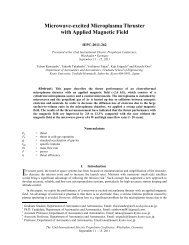Development of a Magnesium and Zinc Hall-effect Thruster
Development of a Magnesium and Zinc Hall-effect Thruster
Development of a Magnesium and Zinc Hall-effect Thruster
Create successful ePaper yourself
Turn your PDF publications into a flip-book with our unique Google optimized e-Paper software.
Fig. 18. I-V plot for the shim anode <strong>and</strong> main anode for the 105 minute porous<br />
anode experiment using magnesium propellant.<br />
Fig. 19. Plot showing main anode current, shim anode current, <strong>and</strong> the anode<br />
temperature as current is shared between the main anode <strong>and</strong> shim anodes.<br />
The temperature data that is reported in Fig. 19 is from a thermocouple that is spot-welded to the back <strong>of</strong> the<br />
anode, as shown in Fig. 17. As expected, the anode temperature increased each time current was shifted from the<br />
shim anode to the main anode, supporting the theory that the main anode temperature was driving an increase in<br />
propellant mass flow. Although the thermal peaks were slightly <strong>of</strong>fset from the main anode current peaks <strong>and</strong> there<br />
The 31 st 14<br />
International Electric Propulsion Conference, University <strong>of</strong> Michigan, USA<br />
September 20 – 24, 2009






